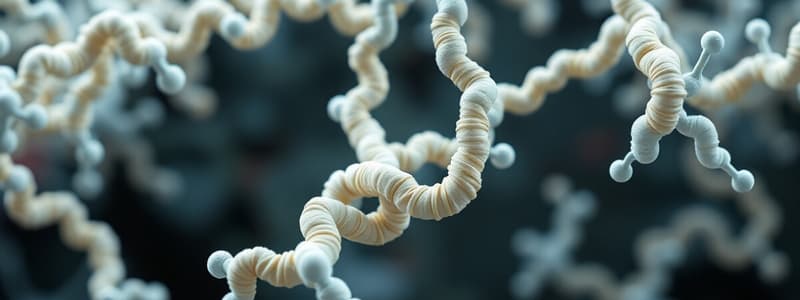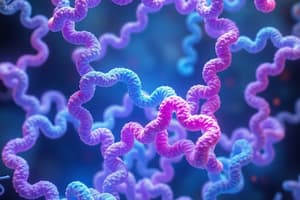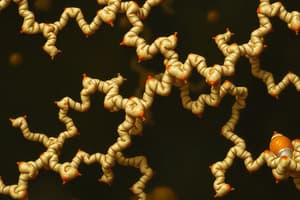Podcast
Questions and Answers
What is the role of chaperonins in protein folding?
What is the role of chaperonins in protein folding?
What can cause denaturation of proteins?
What can cause denaturation of proteins?
What happens to a protein after it undergoes denaturation?
What happens to a protein after it undergoes denaturation?
Which step occurs first in the chaperonin action?
Which step occurs first in the chaperonin action?
Signup and view all the answers
How does the chaperonin cylinder contribute to protein folding?
How does the chaperonin cylinder contribute to protein folding?
Signup and view all the answers
What reaction occurs when two monomers bond together through the loss of a water molecule?
What reaction occurs when two monomers bond together through the loss of a water molecule?
Signup and view all the answers
What term describes the breakdown of polymers into monomers by adding a water molecule?
What term describes the breakdown of polymers into monomers by adding a water molecule?
Signup and view all the answers
Which statement about macromolecules is true?
Which statement about macromolecules is true?
Signup and view all the answers
What is a characteristic feature of polymers despite sharing a limited number of monomer types?
What is a characteristic feature of polymers despite sharing a limited number of monomer types?
Signup and view all the answers
Which of the following accurately describes monomers?
Which of the following accurately describes monomers?
Signup and view all the answers
What type of interaction is primarily responsible for maintaining the tertiary structure of a protein?
What type of interaction is primarily responsible for maintaining the tertiary structure of a protein?
Signup and view all the answers
Which level of protein structure represents the unique sequence of amino acids?
Which level of protein structure represents the unique sequence of amino acids?
Signup and view all the answers
What persistent structural feature is shared by both collagen and hemoglobin?
What persistent structural feature is shared by both collagen and hemoglobin?
Signup and view all the answers
Which of the following correctly describes a characteristic of secondary structures in proteins?
Which of the following correctly describes a characteristic of secondary structures in proteins?
Signup and view all the answers
What can a single amino acid substitution in a protein cause, as illustrated by sickle-cell disease?
What can a single amino acid substitution in a protein cause, as illustrated by sickle-cell disease?
Signup and view all the answers
What type of bond links amino acids together within a polypeptide?
What type of bond links amino acids together within a polypeptide?
Signup and view all the answers
Which type of protein structure may form from the interaction of two or more polypeptide chains?
Which type of protein structure may form from the interaction of two or more polypeptide chains?
Signup and view all the answers
Which statement is true regarding the amino acid side chains in proteins?
Which statement is true regarding the amino acid side chains in proteins?
Signup and view all the answers
What is primarily responsible for the formation of the α helix structure in proteins?
What is primarily responsible for the formation of the α helix structure in proteins?
Signup and view all the answers
Which characteristic of hemoglobin is essential for its function in carrying oxygen?
Which characteristic of hemoglobin is essential for its function in carrying oxygen?
Signup and view all the answers
How does the specific arrangement of amino acids influence protein function?
How does the specific arrangement of amino acids influence protein function?
Signup and view all the answers
What property of R groups distinguishes the 20 different amino acids?
What property of R groups distinguishes the 20 different amino acids?
Signup and view all the answers
What effect do hydrophobic interactions have on protein structure?
What effect do hydrophobic interactions have on protein structure?
Signup and view all the answers
What can result from an alteration in pH for a protein’s structure?
What can result from an alteration in pH for a protein’s structure?
Signup and view all the answers
Study Notes
Protein Structure and Function
- Protein structure can be altered by physical and chemical conditions: changes in pH, salt concentration, temperature, or other environmental factors
- Denaturation occurs when a protein unravels and loses its native structure making it biologically inactive
- Most proteins go through several states on their way to a stable structure
- Chaperonins are protein molecules that assist with the proper folding of other proteins
Enzymes
- Enzymes are a type of protein that acts as a catalyst to speed up chemical reactions
- Enzymes can perform their functions repeatedly, that keep cells running by carrying out the processes of life
- Enzymes have an active site that binds to a specific molecule called a substrate
Polypeptides
- Polypeptides are polymers built from the same set of 20 amino acids
- A protein consists of one or more polypeptides
Amino Acids
- Amino acids are organic molecules with carboxyl and amino groups
- Amino acids differ in their properties due to differing side chains, called R groups
20 Amino Acids
- The 20 amino acids of proteins are categorized based on their side chains' properties (nonpolar, polar, electrically charged)
Amino Acid Polymers
- Amino acids are linked by peptide bonds
- Each polypeptide has a unique linear sequence of amino acids
Four Levels of Protein Structure
- Primary Structure is the unique sequence of amino acids
- Secondary structure consists of coils and folds in the polypeptide chain into a repeating configuration, including an helix and a pleated sheet
- Tertiary structure is determined by interactions among various side chains (R groups)
- Quaternary structure results when two or more polypeptide chains form one macromolecule
Sickle-Cell Disease
- Sickle-cell disease, an inherited blood disorder, results from a single amino acid substitution in the protein hemoglobin
- The change in primary structure affects secondary and tertiary structures, resulting in a sickle shape of red blood cells
Studying That Suits You
Use AI to generate personalized quizzes and flashcards to suit your learning preferences.
Related Documents
Description
This quiz covers the essential concepts of protein structure, enzymes, polypeptides, and amino acids in biology. Learn how physical and chemical factors influence protein behavior and the role of enzymes as catalysts. Test your understanding of these fundamental units of life.




